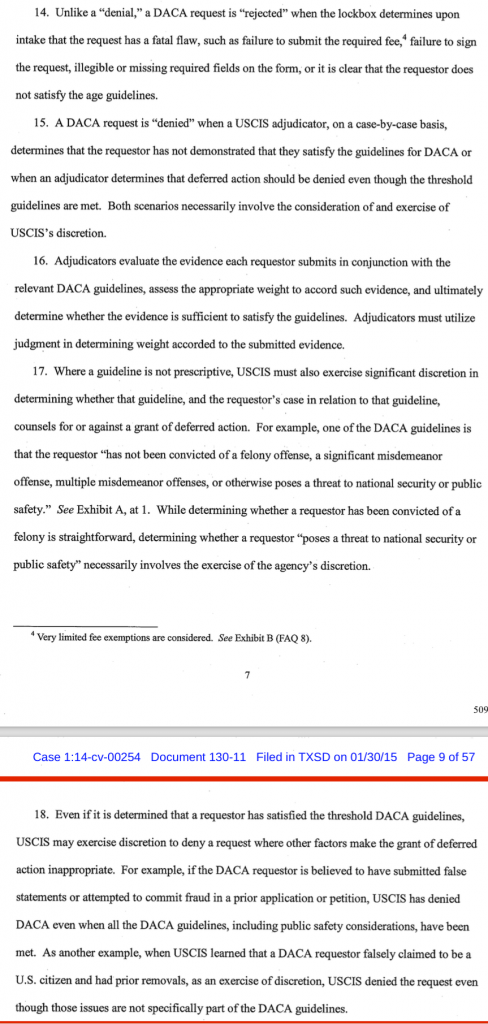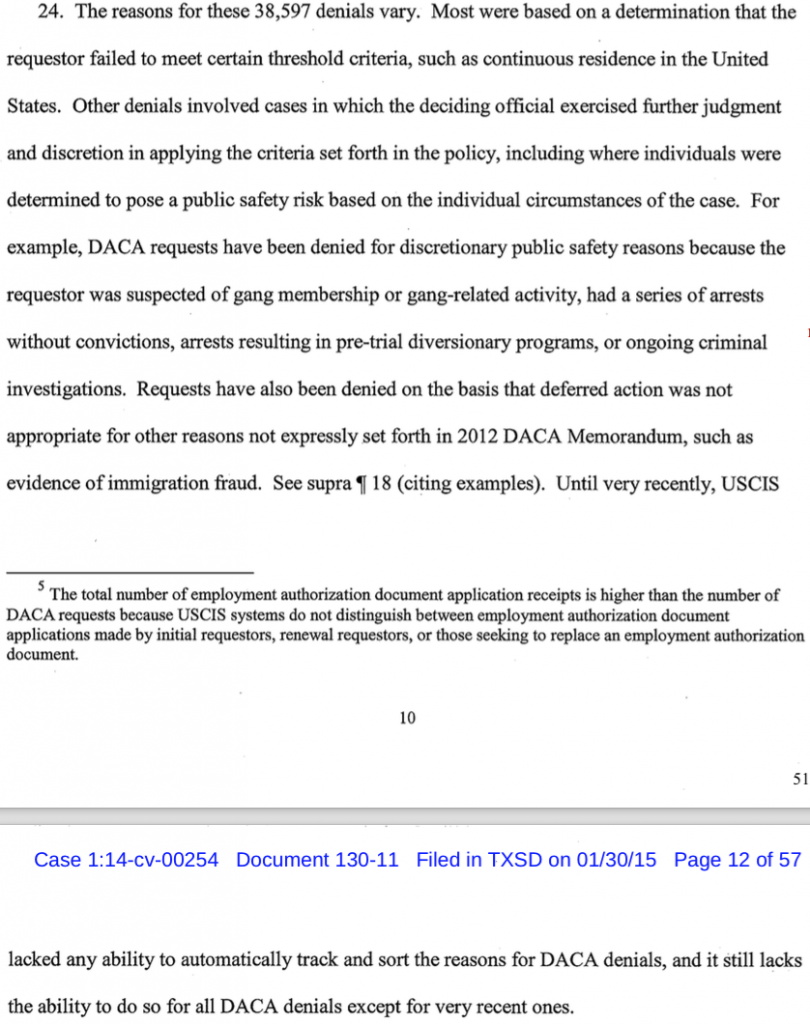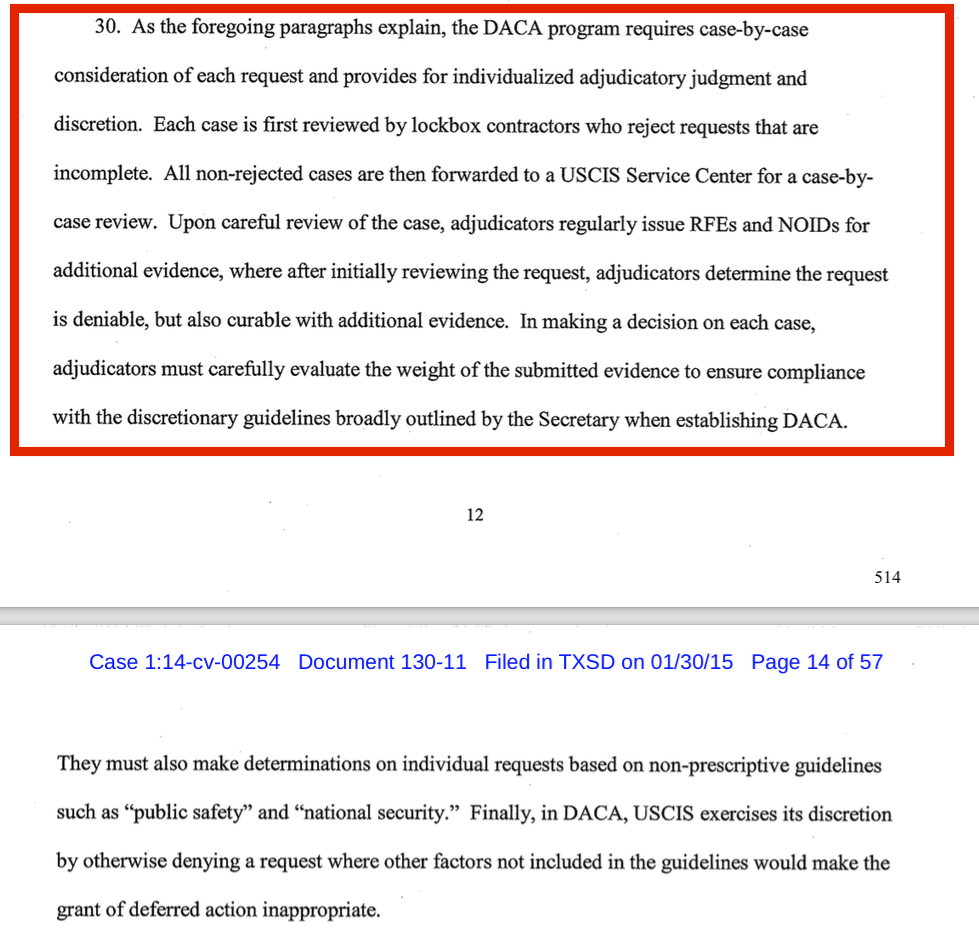DACA did not result in a 100% grant rate. Some may contend that this fact alone suggests there is a case-by-case discretion. If even a single applicant was denied, the argument goes, it isn’t a rubber stamp. Were there any applicants denied for discretionary reasons?
In its sur-reply, the government makes this claim:
In any event, Plaintiffs’ claim of “rubber-stamping” with respect to the existing DACA policy that they carefully avoid challenging is incorrect and rests on erroneous assumptions.28 As an initial matter, approximately six percent of adjudicated DACA requests have been denied, in addition to the six percent that were initially rejected when filed. Defs.’ Opp. at 41.29 The denials have been based on an adjudicator’s case-by-case determination that the requestor has not met the substantive criteria of the policy or for other discretionary reasons. Neufeld Decl.
¶ 15.
The government explains in its brief that there are “concrete” examples where applications have been denied on “decidedly discretionary grounds.”
While these numbers alone (in addition to the express terms of the 2012 DACA policy itself) show that discretion is being exercised under that policy, there are also concrete examples in which requests have been denied based on decidedly discretionary grounds (although the absence of such cases in the record would not be dispositive of the relevant legal issues). See id. ¶¶ 17, 18, 24; see also Amicus Br. of Am. Immigration Council et al. at 2 [ECF No. 39-1) (noting amici’s experience seeing “individuals who meet all of the DACA eligibility requirements [but are] still denied deferred action”).
The problem is, almost every single example the government identifies is someone that is categorically ineligible for DACA.

The declaration from Donald Neufield, Associate Director for Service Center Operations (SCOPS) for USCIS, provides fascinating insights into how DACA operates. Paragraphs 14-18 explain the process by which an application is “denied,” rather than “rejected.”
Paragraph 17 acknowledges that determining if someone committed a “felony” or “significant misdemeanor” is “straightforward, determining whether a requestor ‘poses a threat to national security or public safety’ necessarily involves the exercise of the agency’s discretion.” However, as I noted in a previous post, the only instances submitted to the court where such discretion was identified existed for individuals who committed a felony. This rendered them in the first priority category, and outside the scope of deferred action. The correct test, is whether anyone who did not have a felony or misdemeanors, was deemed ineligible. Even if this number is greater than 0, a trivially small number suggests a very minuscule role for individual discretion.
Paragraph 18 identifies two other possible instances. First “if the DACA requestor is believed to have submitted false statements or attempts to commit fraud in a prior application or petition.” As Texas notes in its supplement:
Moreover, the DACA application itself states that fraud is a “felony” and hence a violation of DHS’s no-felony eligibility criterion. See USCIS Form I- 821D, Consideration of Deferred Action for Childhood Arrivals 5 (attached as Ex. F) (requiring applicant to certify: “I also understand that knowingly and willfully providing materially false information on this form is a federal felony”).
Lying on an application is a felony. But look at the phrasing–“believed to have.” There is no conviction here. In other words, the government is hanging its hat on the fact that a persons is suspected, but not convicted of fraud. This is an awfully slim reed to rely on.
For “another example,” DACA was denied “where USCIS learned that a DACA requestor falsely claimed to be a U.S. Citizen and had prior removals.” If the removals were plural, that means there were several felonies. Ditto for falsely claiming to be a citizen. These seem to be greater than “belief,” as removals are convictions of record.
In paragraph 24, Neufield attempts to explain the basis for the 6% of denials (roughly 38,597). The government writes:
For example, requests have been denied for public safety reasons where the requestor was suspected of gang membership or gang-related activity or had a series of arrests without convictions, arrests resulting in a pre-trial diversionary program, or an ongoing criminal investigation. Neufeld Decl. ¶ 24. In addition, requests have been denied on the basis of factors not expressly set forth in the 2012 DACA guidance, such as where the requestor had made false prior claims of U.S. citizenship. Id. ¶¶ 18, 24. Thus, contrary to Plaintiffs’ unsupported contentions, implementation of 2012 DACA demonstrates the entirely appropriate use of case-by-case discretion.30
First, he cites that “Most were based on a determination that the requestor failed to meet certain threshold criteria, such as continuous residence in the United States.” This is again a category set by the secretary. Second, he repeats that some where denied where they would “pose a public safety risk based on the individual circumstances of the case.” What are the only examples he identified?” Some “DACA requests have been denied for discretionary public safety reasons because the requestor was suspected of gang membership or gang-related activity…”
Once again, “gang membership” renders a person categorically exempt. As Texas notes in its supplement:
It is even more unreasonable to claim that “gang membership” and “fraud” in the DACA-application process qualify as “discretionary” reasons. Sur-reply App. 510, 512. “Gang activity” is expressly prohibited by DHS’s eligibility criteria. See Johnson-Winkowski Memo 3.
In the memo, those who are “convicted” of “gang activity” are in Priority 1 for removal.
aliens convicted of an offense for which an element was active participation in a criminal street gang, as defined in 18 U.S.C. § 52 l(a), or aliens not younger than 16 years of age who intentionally participated in an organized criminal gang to further the illegal activity of the gang;
However, it requires a “conviction” of a gang offense, rather than being “suspected” of doing so. The government may be parsing words here–people suspected of gang activity, but not convicted of it, would not be within the four corners of the policy. If this is the extent of their discretion, they are standing on really, really weak footing.
The other instances identified in paragraph 24 follow the same rubric–“had a series of arrests without convictions, arrests resulting in pre-trial diversionary programs, or ongoing criminal investigations.” All of these instances are lacking a conviction, but suggest a threat to “public safety.”
 Neufield next repeats that “Requests have also been denied on the basis that deferred action was not appropriate for other reasons not expressly set forth in 2012 DACA memorandum, such as evidence of immigration fraud. See supra p. 18 (citing examples.)” But as discussed earlier, these felonies are categorically exempt.
Neufield next repeats that “Requests have also been denied on the basis that deferred action was not appropriate for other reasons not expressly set forth in 2012 DACA memorandum, such as evidence of immigration fraud. See supra p. 18 (citing examples.)” But as discussed earlier, these felonies are categorically exempt.
Neufield closes with an odd admission–until recently, DHS couldn’t track the reasons for denials.
Until very recently, USCIS lacked any ability to automatically track and sort the reasons for DACA denials, and it still lacks the ability to do so for all DACA denials except for very recent ones.
Huh? Officers were required to use the “DACA Denial Template” to select the correct reason for denials. Are we really to believe that DHS thought it was unimportant to track which checkbox was checked? And why was that capability only instituted very recently? Did they not want to know the reasons for denial? The two Notices of Intent to Deny were dated from June and September of 2014, two years after DACA began, which are fairly recent. This is so strange. Maybe they began tracking this in anticipation of the litigation, and the need to show reasons for denials? I will digest this some more, but this admission here seems so out of place.
So at bottom, with it’s last-ditch legal effort to defend DAPA before a judge may rule it unconstitutional, the government cannot identify a single instance where discretion was exercised beyond the scope Secretary’s policies. The furthest they get are people “suspected” of, but not “convicted” of gang activity, or someone with a “series of arrests” or “ongoing criminal investigations.” I find it very, very implausible that there is much discretion here. Would any two agents disagree that someone who had a series of arrests would not pose a risk to “public safety,” and be ineligible for relief? Further, if these are the best examples identified–“series of arrests,” rather than a “single,” arrest, it seems the scope of this review is extremely narrow.
Here is an overview of how Neufield describes the policy:
Finally, what is the relevance of these exhibits? The government has to stress that “the absence of such cases in the record would not be dispositive of the relevant legal issues.” In a footnote, the government claims that these documents are outside the scope of the APA review
29 In the Neufeld Declaration, Defendants provide further details about DHS’s implementation of 2012 DACA at the request of the Court and to respond to some of the points made in Plaintiffs’ papers. Because the 2014 Deferred Action Guidance is, on its face, a valid exercise of DHS’s prosecutorial discretion for the reasons discussed above, the details about the agency’s implementation of 2012 DACA are not necessary to reject Plaintiffs’ pre-enforcement challenge to that Guidance. Moreover, challenges brought pursuant to the APA are ordinarily confined to the administrative record or appropriately explanatory materials. This is in contrast to the Kenneth Palinkas Declaration (Pls.’ Ex. 23) [ECF No. 64- 42] submitted by Plaintiffs, which, aside from reflecting conclusory, generalized assertions lacking support, is unrelated to the agency’s administrative action, and thus does not bear on whether Plaintiffs can demonstrate a likelihood of success on the merits. See Camp v. Pitts, 411 U.S. 138, 142 (1973); see also Harvard Pilgrim Health Care v. Thompson, 318 F. Supp. 2d 1, 10 (D.R.I. 2004) (when constitutional and APA claims overlap, review must be on the administrative record); cf. Seafarers Int’l Union of N. Am. v. U.S., 891 F. Supp. 641, 647 (D.D.C. 1995) (“Although judicial review is normally confined to the administrative record, agency affidavits may be used to supplement the administrative record to further explain the administrative record and describe the background information that was available to the agency”) (emphasis added).
But the strategic decision to attach these exhibits–which were not present in earlier briefings–suggests the government does not think this position will prevail. As I explain in Part II:
To analyze the constitutionality of DAPA, we must first address its progenitor—DACA. Secretary Johnson, in establishing DAPA, “direct[ed] USCIS to establish a process, similar to DACA, for exercising prosecutorial discretion through the use of deferred action, on a case-by-case basis.” Secretary Johnson’s memorandum mirrors his predecessor, Secretary Janet Napolitano’s invocation of discretion. It begins that “DHS must exercise prosecutorial discretion in the enforcement of the law.” While DAPA has not yet gone into effect, it is safe to assume that it will adopt priorities and guidelines “similar” to those of DACA, except on a much larger scale.
The only way to understand DAPA is to look at DACA. The courts may find DAPA constitutional, but this case will not be resolved because it has not gone into effect. For once it goes into effect, there will be irreparable harm as millions of people will receive work authorizations. Based on the equities, it will be impossible to claw this back.
The fact that the government devotes so much of its brief to explaining how DACA works–something it did not do before–suggests this history will be more than relevant.
